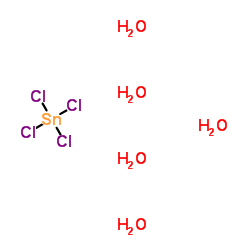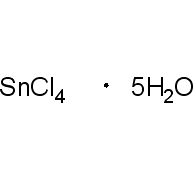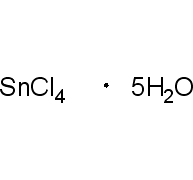四氯化锡(IV) 五水合物, AR,99.00,Tin(IV) chloride pentahydrate
产品编号:西域试剂-WR366571| CAS NO:10026-06-9| MDL NO:MFCD00149864| 分子式:SnCl4·5H2O| 分子量:350.6
本网站销售的所有产品仅用于工业应用或者科学研究等非医疗目的,不可用于人类或动物的临床诊断或者治疗,非药用,非食用,
| 产品名称 | 四氯化锡(IV) 五水合物, AR,99.00 |
|---|---|
| 英文名称 | Tin(IV) chloride pentahydrate |
| CAS编号 | 10026-06-9 |
| 产品熔点 | 56 °C |
| 产品沸点 | 114.1ºC at 760 mmHg |
| 精确质量 | 349.830444 |
| PSA | 46.15000 |
| LogP | 2.05570 |
| 外观性状 | 白色至黄色固体 |
| 蒸气压 | 23.9mmHg at 25°C |
| 溶解性 | soluble |
| 稳定性 | Stable, but may decompose in contact with moisture or water. Incompatible with strong acids. |
| 储存条件 | 库房通风低温干燥,与碱分开存放 |
相关文档
化学品安全说明书(MSDS)
下载MSDS质检证书(COA)
相关产品
| 符号 |

GHS05 |
|---|---|
| 信号词 | Danger |
| 危害声明 | H314 |
| 警示性声明 | P260-P280-P303 + P361 + P353-P304 + P340 + P310-P305 + P351 + P338 |
| 危害码 (欧洲) | C: Corrosive; |
| 风险声明 (欧洲) | R34;R52/53 |
| 安全声明 (欧洲) | S26-S36/37/39-S45-S7/8-S61 |
| 危险品运输编码 | UN 2440 8/PG 3 |
| WGK德国 | 3 |
| RTECS号 | XP8870000 |
| 包装等级 | III |
| 危险类别 | 8 |
|
Section 1: Product Identification Chemical Name:Tin (IV) chloride pentahydrate, 98% CAS Registry Number:10026-06-9 Formula:SnCl4.5H2O EINECS Number:231-588-9 Chemical Family:metal halide Synonym:Stannic chloride pentahydrate, Tetrachlorostannane pentahydrate, Tin tetrachloride dihydrate
Section 2: Composition and Information on Ingredients IngredientCAS NumberPercentACGIH (TWA)OSHA (PEL) Title Compound10026-06-9100%2mg/m32mg/m3 Section 3: Hazards Identification Emergency Overview:May be harmful by inhalation. Corrosive to skin and eyes. Primary Routes of Exposure:Contact with skin and eyes. Inhalation of dust. Eye Contact:Corrosive to the eyes. Skin Contact:Causes burns to the skin. May be harmful by inhalation. Forms hydrogen chloride when heated. Inhalation can lead to chemical burns to Inhalation: the respiratory tract. Ingestion:No information is available on the acute physiological effects of ingestion. Corrosive to skin, eyes and respiratory tract and causes eye, skin burns, dyspnea (breathing difficulty), and Acute Health Affects: pulmonary edema Chronic Health Affects:Prolonged exposure to dust of tin compounds may result in benign pneumoconiosis. NTP:No IARC:No OSHA:No SECTION 4: First Aid Measures Immediately flush the eyes with copious amounts of water for at least 10-15 minutes. A victim may need Eye Exposure: assistance in keeping their eye lids open. Get immediate medical attention. Wash the affected area with water. Remove contaminated clothes if necessary. Seek medical assistance if Skin Exposure: irritation persists. Remove the victim to fresh air. Closely monitor the victim for signs of respiratory problems, such as difficulty Inhalation: in breathing, coughing, wheezing, or pain. In such cases seek immediate medical assistance. Seek medical attention immediately. Keep the victim calm. Give the victim water (only if conscious). Induce Ingestion: vomiting only if directed by medical personnel. SECTION 5: Fire Fighting Measures Flash Point:not applicable Autoignition Temperature:none Explosion Limits:none Extinguishing Medium:None. Material is non-flammable. If this product is involved in a fire, fire fighters should be equipped with a NIOSH approved positive pressure Special Fire Fighting Procedures: self-contained breathing apparatus and full protective clothing. Hazardous Combustion andIf involved in a fire this material may emit toxic fumes of hydrogen chloride. Decomposion Products: Unusual Fire or Explosion Hazards: No unusual fire or explosion hazards. SECTION 6: Accidental Release Measures To avoid raising dust, small spills may be mixed with diatomaceous earth, sand, vermiculite or other suitable Spill and Leak Procedures: inert material and swept up. SECTION 7: Handling and Storage Handling and Storage:Store solid in a tightly sealed container. SECTION 8: Exposure Controls and Personal Protection Eye Protection:Always wear approved safety glasses when handling a chemical substance in the laboratory. Skin Protection:Wear protective clothing and gloves. Consult with glove manufacturer to determine the proper type of glove. Ventilation:Solid may form a fine dust. If possible, handle the solid in an efficient fume hood. If in form of fine dust and ventilation is not available a respirator should be worn. The use of respirators Respirator: requires a Respirator Protection Program to be in compliance with 29 CFR 1910.134. Ventilation:Solid may form a fine dust. If possible, handle the solid in an efficient fume hood. Additional Protection:No additional protection required. SECTION 9: Physical and Chemical Properties Color and Form:off-white lumps Molecular Weight:260.50 (350.61) Melting Point:no data Boiling Point:no data Vapor Pressure:no data Specific Gravity:no data Odor:none Solubility in Water:soluble SECTION 10: Stability and Reactivity Stability:air and moisture stable Hazardous Polymerization:no hazardous polymerization Conditions to Avoid:none Incompatibility:active metals Decomposition Products:water, metal oxychloride, metal oxide, and hydrogen chloride SECTION 11: Toxicological Information Intraperitoneal (rat); LD50: 120 mg/kg. Intravenous (mouse); LD50: 32 mg/kg. Human Lymphocyte; RTECS Data: Cytogenetic analysis: 2 mg/L. Human Lymphocyte; Sister chromatid exchange: 2 mg/L. Carcinogenic Effects:no data Mutagenic Effects:Negative data Tetratogenic Effects:no data SECTION 12: Ecological Information Ecological Information:Harmful to aquatic organisms. May cause long-term adverse effects in the aquatic environment. SECTION 13: Disposal Considerations Disposal:Dispose of according to local, state and federal regulations. SECTION 14: Transportation Shipping Name (CFR):Stannic chloride, pentahydrate Hazard Class (CFR):8 Additional Hazard Class (CFR):NA Packaging Group (CFR):III UN ID Number (CFR):UN# 2440 Shipping Name (IATA):Stannic chloride, pentahydrate Hazard Class (IATA):8 Additional Hazard Class (IATA):NA Packaging Group (IATA):III UN ID Number (IATA):UN# 2440 SECTION 15: Regulatory Information TSCA:Not listed in the TSCA inventory. SARA (Title 313):Title compound not listed. Second Ingredient:none SECTION 16 - ADDITIONAL INFORMATION N/A |











 浙公网安备 33010802013016号
浙公网安备 33010802013016号